Aged G Protein-Coupled Receptor Kinase 3 (Grk3)-Deficient Mice Exhibit Enhanced Osteoclastogenesis and Develop Bone Lesions Analogous to Human Paget’s Disease of Bone
Abstract
1. Introduction
2. Materials and Methods
2.1. Query of Publicly Available Expression Data
2.2. Mice
2.3. Grk3 Knockdown of RAW 264.7 Cells
2.4. Osteoclast Differentiation of RAW Cells
2.5. Grk3 mRNA Expression of RAW Cells, RAW-OCLs, and Grk3-Knockdown RAW Clones
2.6. Flow Cytometric Analysis of RAW Grk3-Knockdown Osteoclasts
2.7. Resorption Assay
2.8. Analysis of Primary Wild-Type and Grk3-Deficient Osteoclasts
2.9. RNAseq of Osteoclast Progenitor Cells
2.10. Micro-Computed Tomography (µCT)
2.11. TRAP Staining
2.12. Immunofluorescent Staining
2.13. Ki67 Staining
2.14. β Galactosidase Staining
2.15. Serum ELISAs
2.16. Expression of Grk3 in Human Peripheral Blood
2.17. Statistics
3. Results
3.1. Aged Grk3−/− Mice Have Abnormal Bone Lesions That Are Osteoclast Rich and Resemble PDB by µCT and Histopathology
3.2. Grk3 Expression Is Upregulated in Human and Mouse Cells during Osteoclastogenesis
3.3. Grk3 Expression Is Decreased in Peripheral Blood Mononuclear Cells from PDB Patients
3.4. Grk3−/− Osteoclast Progenitors Show Decreased Histone Gene Expression Compared to Controls
3.5. Grk3 Deficiency Increases Proliferation of Osteoclast Precursors, Which May Contribute to Increased Osteoclastogenesis
3.6. Grk3 Deficiency Does Not Affect Resorption Capacity of Osteoclasts
3.7. Serum Biomarkers of Bone Remodeling Associated with PDB Are Altered in Aged Grk3−/− Mice
4. Discussion
Supplementary Materials
Author Contributions
Funding
Institutional Review Board Statement
Informed Consent Statement
Data Availability Statement
Acknowledgments
Conflicts of Interest
References
- Ralston, S.H.; Langston, A.L.; Reid, I.R. Pathogenesis and management of Paget’s disease of bone. Lancet 2008, 372, 155–163. [Google Scholar] [CrossRef] [PubMed]
- Rabjohns, E.M.; Hurst, K.; Ghosh, A.; Cuellar, M.C.; Rampersad, R.R.; Tarrant, T.K. Paget’s Disease of Bone: Osteoimmunology and Osteoclast Pathology. Curr. Allergy Asthma Rep. 2021, 21, 23. [Google Scholar] [CrossRef] [PubMed]
- Singer, F.R.; Bone, H.G.; Hosking, D.J.; Lyles, K.W.; Murad, M.H.; Reid, I.R.; Siris, E.S.; Endocrine, S. Paget’s disease of bone: An endocrine society clinical practice guideline. J. Clin. Endocrinol. Metab. 2014, 99, 4408–4422. [Google Scholar] [CrossRef] [PubMed]
- Laurin, N.; Brown, J.P.; Morissette, J.; Raymond, V. Recurrent mutation of the gene encoding sequestosome 1 (SQSTM1/p62) in Paget disease of bone. Am. J. Hum. Genet. 2002, 70, 1582–1588. [Google Scholar] [CrossRef]
- Layfield, R.; Hocking, L.J. SQSTM1 andWdisease of bone. Calcif. Tissue Int. 2004, 75, 347–357. [Google Scholar] [CrossRef] [PubMed]
- Rea, S.L.; Walsh, J.P.; Layfield, R.; Ratajczak, T.; Xu, J. New insights into the role of sequestosome 1/p62 mutant proteins in the pathogenesis of Paget’s disease of bone. Endocr. Rev. 2013, 34, 501–524. [Google Scholar] [CrossRef]
- Albagha, O.M.; Visconti, M.R.; Alonso, N.; Langston, A.L.; Cundy, T.; Dargie, R.; Dunlop, M.G.; Fraser, W.D.; Hooper, M.J.; Isaia, G.; et al. Genome-wide association study identifies variants at CSF1, OPTN and TNFRSF11A as genetic risk factors for Paget’s disease of bone. Nat. Genet. 2010, 42, 520–524. [Google Scholar] [CrossRef] [PubMed]
- Daroszewska, A.; Hocking, L.J.; McGuigan, F.E.; Langdahl, B.; Stone, M.D.; Cundy, T.; Nicholson, G.C.; Fraser, W.D.; Ralston, S.H. Susceptibility to Paget’s disease of bone is influenced by a common polymorphic variant of osteoprotegerin. J. Bone Miner. Res. 2004, 19, 1506–1511. [Google Scholar] [CrossRef]
- Beyens, G.; Daroszewska, A.; de Freitas, F.; Fransen, E.; Vanhoenacker, F.; Verbruggen, L.; Zmierczak, H.G.; Westhovens, R.; Van Offel, J.; Ralston, S.H.; et al. Identification of sex-specific associations between polymorphisms of the osteoprotegerin gene, TNFRSF11B, and Paget’s disease of bone. J. Bone Miner. Res. 2007, 22, 1062–1071. [Google Scholar] [CrossRef]
- Kurihara, N.; Hiruma, Y.; Zhou, H.; Subler, M.A.; Dempster, D.W.; Singer, F.R.; Reddy, S.V.; Gruber, H.E.; Windle, J.J.; Roodman, G.D. Mutation of the sequestosome 1 (p62) gene increases osteoclastogenesis but does not induce Paget disease. J. Clin. Investig. 2007, 117, 133–142. [Google Scholar] [CrossRef]
- Daroszewska, A.; van ‘t Hof, R.J.; Rojas, J.A.; Layfield, R.; Landao-Basonga, E.; Rose, L.; Rose, K.; Ralston, S.H. A point mutation in the ubiquitin-associated domain of SQSMT1 is sufficient to cause a Paget’s disease-like disorder in mice. Hum. Mol. Genet. 2011, 20, 2734–2744. [Google Scholar] [CrossRef]
- Daroszewska, A.; Rose, L.; Sarsam, N.; Charlesworth, G.; Prior, A.; Rose, K.; Ralston, S.H.; van’t Hof, R.J. Zoledronic acid prevents pagetic-like lesions and accelerated bone loss in the p62(P394L) mouse model of Paget’s disease. Dis. Model. Mech. 2018, 11, dmm035576. [Google Scholar] [CrossRef] [PubMed]
- Obaid, R.; Wani, S.E.; Azfer, A.; Hurd, T.; Jones, R.; Cohen, P.; Ralston, S.H.; Albagha, O.M.E. Optineurin Negatively Regulates Osteoclast Differentiation by Modulating NF-kappaB and Interferon Signaling: Implications for Paget’s Disease. Cell Rep. 2015, 13, 1096–1102. [Google Scholar] [CrossRef]
- Wong, S.W.; Huang, B.W.; Hu, X.; Ho, K.E.; Kolb, J.P.; Padilla, R.J.; Xue, P.; Wang, L.; Oguin, T.H.; Miguez, P.A.; et al. Global deletion of Optineurin results in altered type I IFN signaling and abnormal bone remodeling in a model of Paget’s disease. Cell Death Differ. 2020, 27, 71–84. [Google Scholar] [CrossRef] [PubMed]
- Hu, X.; Wong, S.W.; Liang, K.; Wu, T.H.; Wang, S.; Wang, L.; Liu, J.; Yamauchi, M.; Foster, B.L.; Ting, J.P.; et al. Optineurin regulates NRF2-mediated antioxidant response in a mouse model of Paget’s disease of bone. Sci. Adv. 2023, 9, eade6998. [Google Scholar] [CrossRef] [PubMed]
- Lefkowitz, R.J. G protein-coupled receptors. III. New roles for receptor kinases and beta-arrestins in receptor signaling and desensitization. J. Biol. Chem. 1998, 273, 18677–18680. [Google Scholar] [CrossRef]
- Brozowski, J.M.; Billard, M.J.; Tarrant, T.K. Targeting the molecular and cellular interactions of the bone marrow niche in immunologic disease. Curr. Allergy Asthma. Rep. 2014, 14, 402. [Google Scholar] [CrossRef]
- Spurney, R.F.; Flannery, P.J.; Garner, S.C.; Athirakul, K.; Liu, S.; Guilak, F.; Quarles, L.D. Anabolic effects of a G protein-coupled receptor kinase inhibitor expressed in osteoblasts. J. Clin. Investig. 2002, 109, 1361–1371. [Google Scholar] [CrossRef]
- Flannery, P.J.; Spurney, R.F. Domains of the parathyroid hormone (PTH) receptor required for regulation by G protein-coupled receptor kinases (GRKs). Biochem. Pharmacol. 2001, 62, 1047–1058. [Google Scholar] [CrossRef]
- Spurney, R.F. Regulated expression of G protein-coupled receptor kinases (GRK’s) and beta-arrestins in osteoblasts. Calcif. Tissue Int. 2003, 73, 153–160. [Google Scholar] [CrossRef]
- Brozowski, J.M.; Timoshchenko, R.G.; Serafin, D.S.; Allyn, B.; Koontz, J.; Rabjohns, E.M.; Rampersad, R.R.; Ren, Y.; Eudy, A.M.; Harris, T.F.; et al. G protein-coupled receptor kinase 3 modulates mesenchymal stem cell proliferation and differentiation through sphingosine-1-phosphate receptor regulation. Stem Cell Res. Ther. 2022, 13, 37. [Google Scholar] [CrossRef] [PubMed]
- Madel, M.B.; Ibanez, L.; Rouleau, M.; Wakkach, A.; Blin-Wakkach, C. A Novel Reliable and Efficient Procedure for Purification of Mature Osteoclasts Allowing Functional Assays in Mouse Cells. Front. Immunol. 2018, 9, 2567. [Google Scholar] [CrossRef] [PubMed]
- Jacquin, C.; Gran, D.E.; Lee, S.K.; Lorenzo, J.A.; Aguila, H.L. Identification of multiple osteoclast precursor populations in murine bone marrow. J. Bone Miner. Res. 2006, 21, 67–77. [Google Scholar] [CrossRef] [PubMed]
- Ikic Matijasevic, M.; Flegar, D.; Kovacic, N.; Katavic, V.; Kelava, T.; Sucur, A.; Ivcevic, S.; Cvija, H.; Lazic, M.E.; Kalajzic, I.; et al. Increased chemotaxis and activity of circulatory myeloid progenitor cells may contribute to enhanced osteoclastogenesis and bone loss in the C57BL/6 mouse model of collagen-induced arthritis. Clin. Exp. Immunol. 2016, 186, 321–335. [Google Scholar] [CrossRef] [PubMed]
- Wang, C.; Inzana, J.A.; Mirando, A.J.; Ren, Y.; Liu, Z.; Shen, J.; O’Keefe, R.J.; Awad, H.A.; Hilton, M.J. NOTCH signaling in skeletal progenitors is critical for fracture repair. J. Clin. Investig. 2016, 126, 1471–1481. [Google Scholar] [CrossRef]
- Kurnit, K.C.; Draisey, A.; Kazen, R.C.; Chung, C.; Phan, L.H.; Harvey, J.B.; Feng, J.; Xie, S.; Broaddus, R.R.; Bowser, J.L. Loss of CD73 shifts transforming growth factor-beta1 (TGF-beta1) from tumor suppressor to promoter in endometrial cancer. Cancer Lett. 2021, 505, 75–86. [Google Scholar] [CrossRef]
- Yun, J.; Hansen, S.; Morris, O.; Madden, D.T.; Libeu, C.P.; Kumar, A.J.; Wehrfritz, C.; Nile, A.H.; Zhang, Y.; Zhou, L.; et al. Senescent cells perturb intestinal stem cell differentiation through Ptk7 induced noncanonical Wnt and YAP signaling. Nat. Commun. 2023, 14, 156. [Google Scholar] [CrossRef] [PubMed]
- Carey, H.A.; Hildreth, B.E.; Geisler, J.A.; Nickel, M.C.; Cabrera, J.; Ghosh, S.; Jiang, Y.; Yan, J.; Lee, J.; Makam, S.; et al. Enhancer variants reveal a conserved transcription factor network governed by PU.1 during osteoclast differentiation. Bone Res. 2018, 6, 8. [Google Scholar] [CrossRef]
- Yuen, T.; Stachnik, A.; Iqbal, J.; Sgobba, M.; Gupta, Y.; Lu, P.; Colaianni, G.; Ji, Y.; Zhu, L.L.; Kim, S.M.; et al. Bisphosphonates inactivate human EGFRs to exert antitumor actions. Proc. Natl. Acad. Sci. USA 2014, 111, 17989–17994. [Google Scholar] [CrossRef]
- Lattin, J.E.; Schroder, K.; Su, A.I.; Walker, J.R.; Zhang, J.; Wiltshire, T.; Saijo, K.; Glass, C.K.; Hume, D.A.; Kellie, S.; et al. Expression analysis of G Protein-Coupled Receptors in mouse macrophages. Immunome Res. 2008, 4, 5. [Google Scholar] [CrossRef]
- Chen, D.; Shi, Z.; Feng, X. The RANK IVVY Motif-regulated Genes in Osteoclastogenesis. BioStudies. 2011. Available online: https://www.ebi.ac.uk/biostudies/arrayexpress/studies/E-GEOD-30160 (accessed on 7 February 2023).
- Madel, M.B.; Ibanez, L.; Wakkach, A.; de Vries, T.J.; Teti, A.; Apparailly, F.; Blin-Wakkach, C. Immune Function and Diversity of Osteoclasts in Normal and Pathological Conditions. Front. Immunol. 2019, 10, 1408. [Google Scholar] [CrossRef] [PubMed]
- Jules, J.; Wang, S.; Shi, Z.; Liu, J.; Wei, S.; Feng, X. The IVVY Motif and Tumor Necrosis Factor Receptor-associated Factor (TRAF) Sites in the Cytoplasmic Domain of the Receptor Activator of Nuclear Factor kappaB (RANK) Cooperate to Induce Osteoclastogenesis. J. Biol. Chem. 2015, 290, 23738–23750. [Google Scholar] [CrossRef] [PubMed]
- O’Sullivan, R.J.; Kubicek, S.; Schreiber, S.L.; Karlseder, J. Reduced histone biosynthesis and chromatin changes arising from a damage signal at telomeres. Nat. Struct. Mol. Biol. 2010, 17, 1218–1225. [Google Scholar] [CrossRef] [PubMed]
- Feser, J.; Truong, D.; Das, C.; Carson, J.J.; Kieft, J.; Harkness, T.; Tyler, J.K. Elevated histone expression promotes life span extension. Mol. Cell 2010, 39, 724–735. [Google Scholar] [CrossRef] [PubMed]
- Santos-Otte, P.; Leysen, H.; van Gastel, J.; Hendrickx, J.O.; Martin, B.; Maudsley, S. G Protein-Coupled Receptor Systems and Their Role in Cellular Senescence. Comput. Struct. Biotechnol. J. 2019, 17, 1265–1277. [Google Scholar] [CrossRef] [PubMed]
- Tarrant, T.K.; Billard, M.J.; Timoshchenko, R.G.; McGinnis, M.W.; Serafin, D.S.; Foreman, O.; Esserman, D.A.; Chao, N.J.; Lento, W.E.; Lee, D.M.; et al. G protein-coupled receptor kinase-3-deficient mice exhibit WHIM syndrome features and attenuated inflammatory responses. J. Leukoc. Biol. 2013, 94, 1243–1251. [Google Scholar] [CrossRef]
- Peppel, K.; Boekhoff, I.; McDonald, P.; Breer, H.; Caron, M.G.; Lefkowitz, R.J. G protein-coupled receptor kinase 3 (GRK3) gene disruption leads to loss of odorant receptor desensitization. J. Biol. Chem. 1997, 272, 25425–25428. [Google Scholar] [CrossRef]
- Kong, L.; Smith, W.; Hao, D. Overview of RAW264.7 for osteoclastogensis study: Phenotype and stimuli. J. Cell Mol. Med. 2019, 23, 3077–3087. [Google Scholar] [CrossRef]
- Weigel, M.T.; Dowsett, M. Current and emerging biomarkers in breast cancer: Prognosis and prediction. Endocr.-Relat. Cancer 2010, 17, R245–R262. [Google Scholar] [CrossRef]
- Alvarez, L.; Guanabens, N.; Peris, P.; Monegal, A.; Bedini, J.L.; Deulofeu, R.; de Martinez, M.J.; Munoz-Gomez, J.; Rivera-Fillat, F.; Ballesta, A.M. Discriminative value of biochemical markers of bone turnover in assessing the activity of Paget’s disease. J. Bone Miner. Res. 1995, 10, 458–465. [Google Scholar] [CrossRef]
- Torres, R.; de la Piedra, C.; Rapado, A. Clinical usefulness of serum tartrate-resistant acid phosphatase in Paget’s disease of bone: Correlation with other biochemical markers of bone remodelling. Calcif. Tissue Int. 1991, 49, 14–16. [Google Scholar] [CrossRef] [PubMed]
- Al Nofal, A.A.; Altayar, O.; BenKhadra, K.; Qasim Agha, O.Q.; Asi, N.; Nabhan, M.; Prokop, L.J.; Tebben, P.; Murad, M.H. Bone turnover markers in Paget’s disease of the bone: A Systematic review and meta-analysis. Osteoporos Int. 2015, 26, 1875–1891. [Google Scholar] [CrossRef] [PubMed]
- Minisola, S.; Dionisi, S.; Pacitti, M.T.; Paglia, F.; Carnevale, V.; Scillitani, A.; Mazzaferro, S.; De, G.S.; Pepe, J.; Derasmo, E.; et al. Gender differences in serum markers of bone resorption in healthy subjects and patients with disorders affecting bone. Osteoporos Int. 2002, 13, 171–175. [Google Scholar] [CrossRef] [PubMed]
- Gorissen, B.; de Bruin, A.; Miranda-Bedate, A.; Korthagen, N.; Wolschrijn, C.; de Vries, T.J.; van Weeren, R.; Tryfonidou, M.A. Hypoxia negatively affects senescence in osteoclasts and delays osteoclastogenesis. J. Cell Physiol. 2018, 234, 414–426. [Google Scholar] [CrossRef] [PubMed]
- Liao, J.; Qian, J.; Fang, Y.; Chen, Z.; Zhuang, X.; Zhang, N.; Shao, X.; Hu, Y.; Yang, P.; Cheng, J.; et al. De novo analysis of bulk RNA-seq data at spatially resolved single-cell resolution. Nat. Commun. 2022, 13, 6498. [Google Scholar] [CrossRef] [PubMed]
- Billard, M.J.; Fitzhugh, D.J.; Parker, J.S.; Brozowski, J.M.; McGinnis, M.W.; Timoshchenko, R.G.; Serafin, D.S.; Lininger, R.; Klauber-Demore, N.; Sahagian, G.; et al. G Protein Coupled Receptor Kinase 3 Regulates Breast Cancer Migration, Invasion, and Metastasis. PLoS ONE 2016, 11, e0152856. [Google Scholar] [CrossRef]
- Galson, D.L.; Roodman, G.D. Pathobiology of Paget’s Disease of Bone. J. Bone Metab. 2014, 21, 85–98. [Google Scholar] [CrossRef] [PubMed]
- Lagerstrom, M.C.; Schioth, H.B. Structural diversity of G protein-coupled receptors and significance for drug discovery. Nat. Rev. Drug Discov. 2008, 7, 339–357. [Google Scholar] [CrossRef]

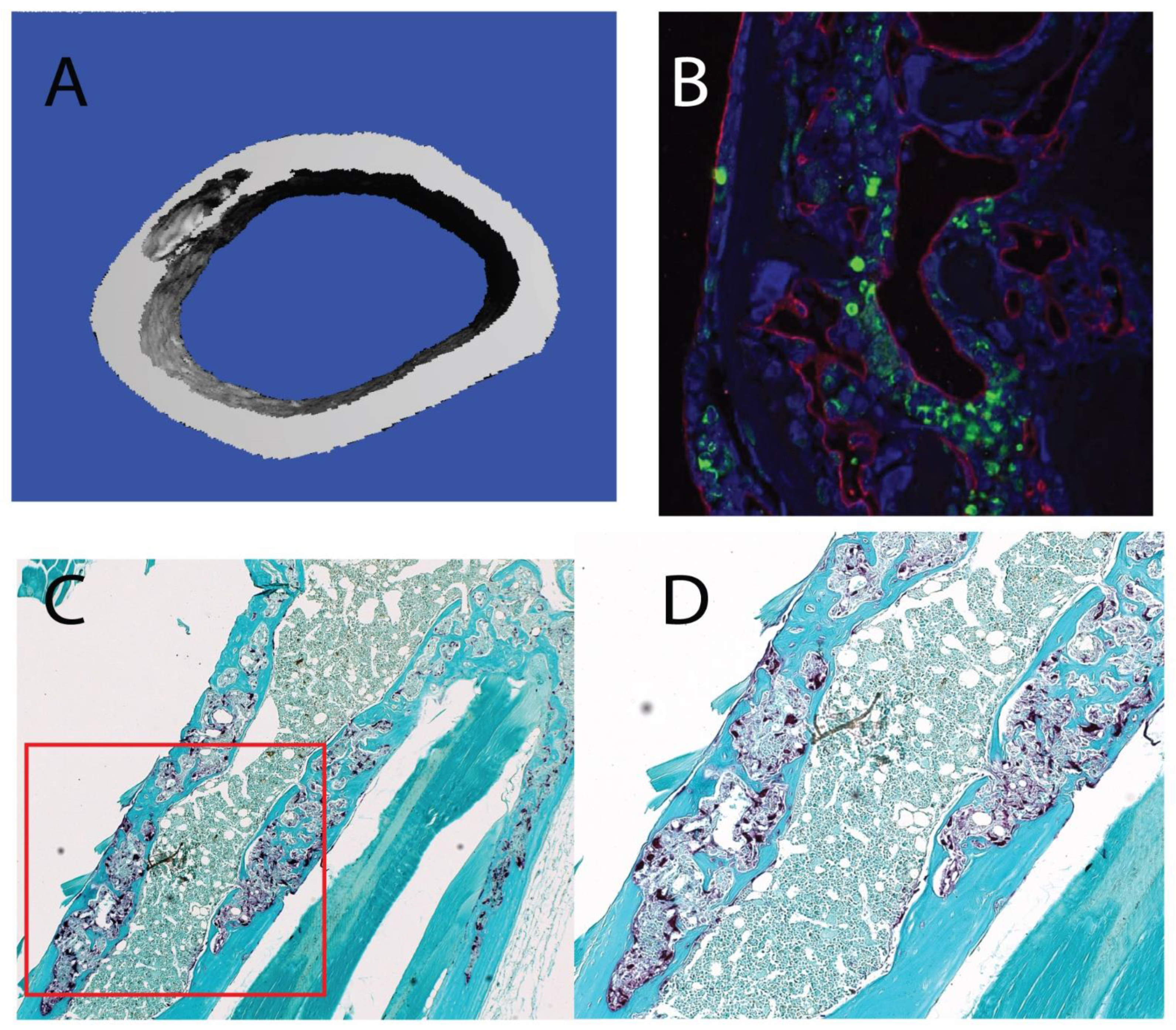

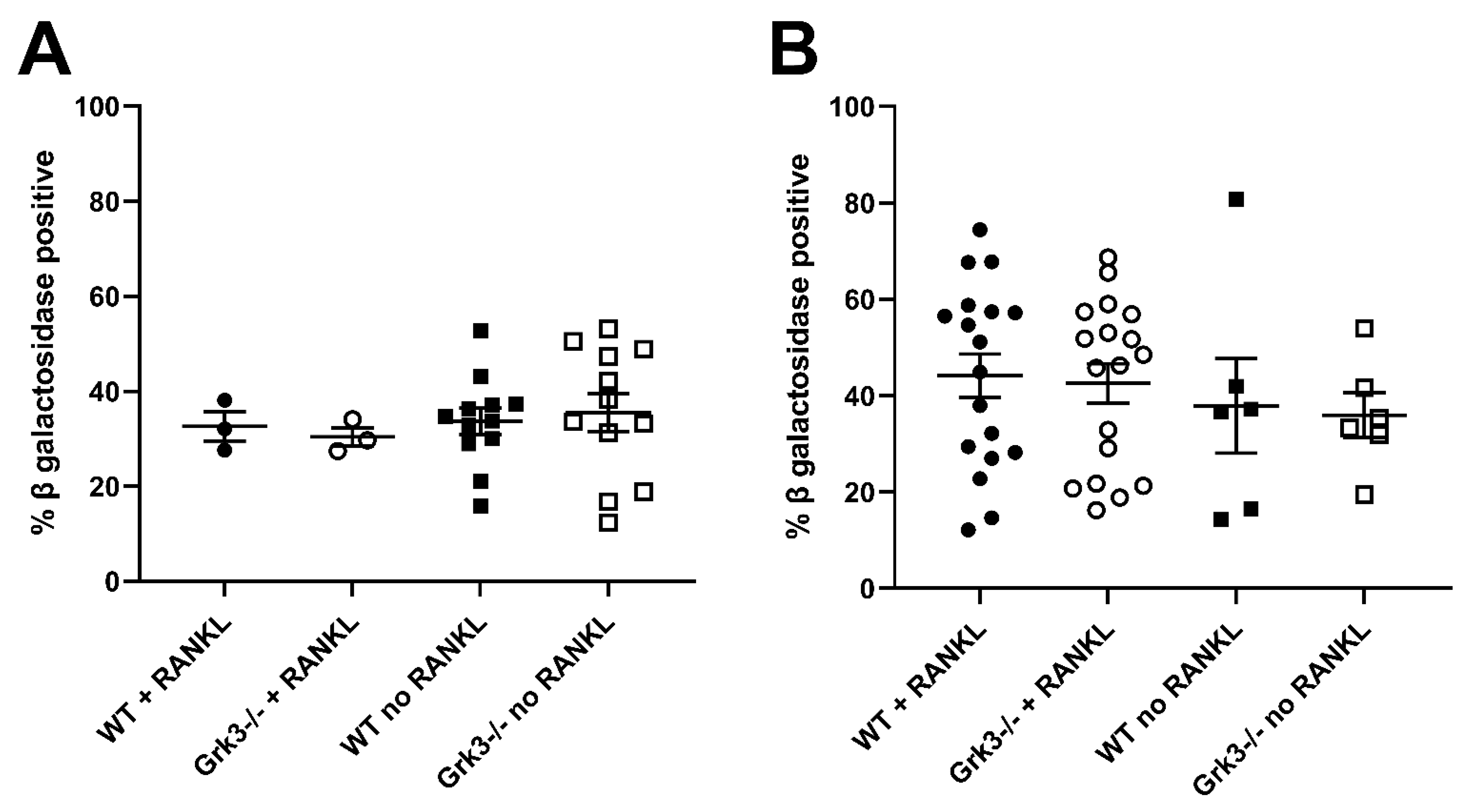

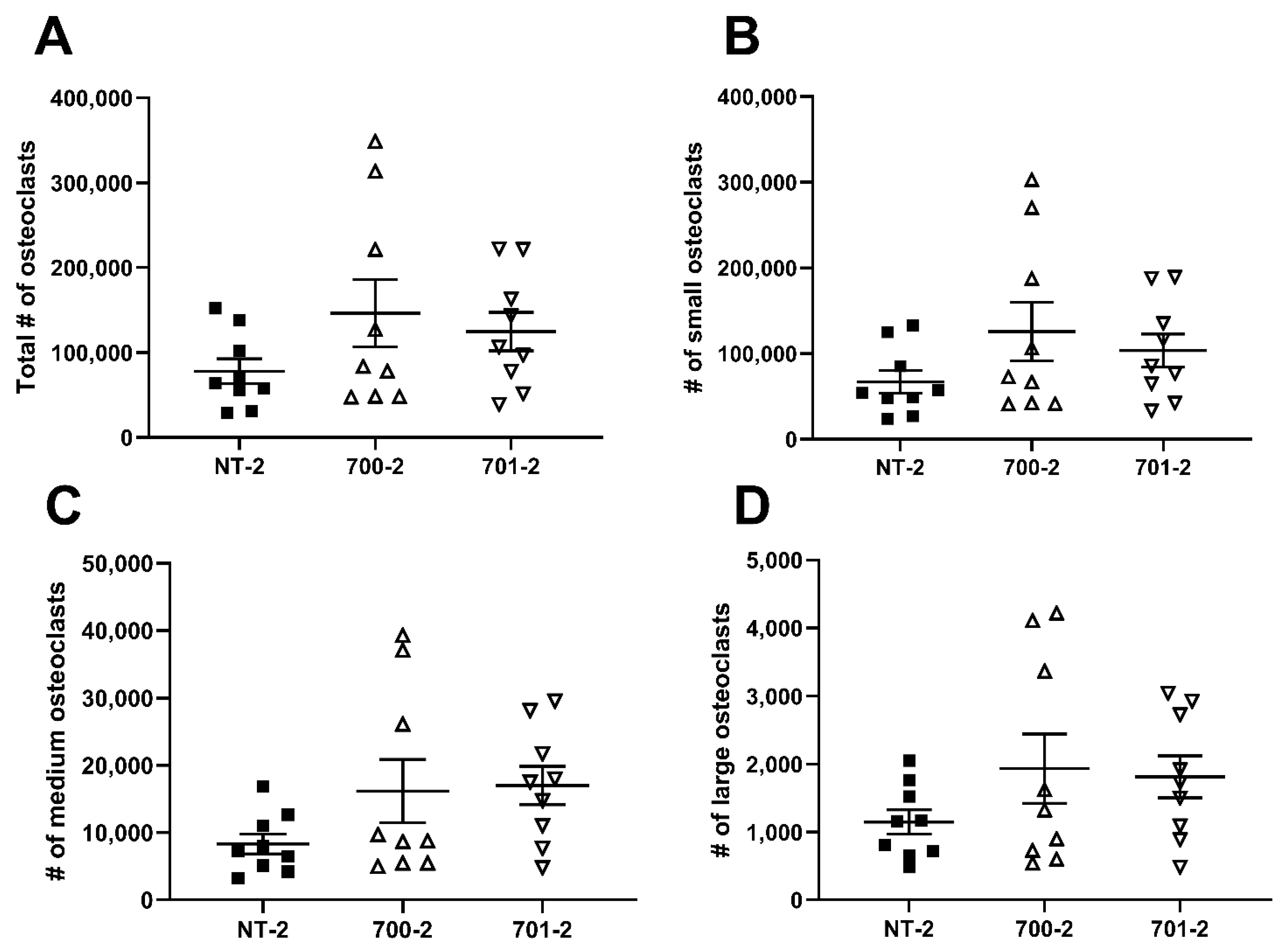
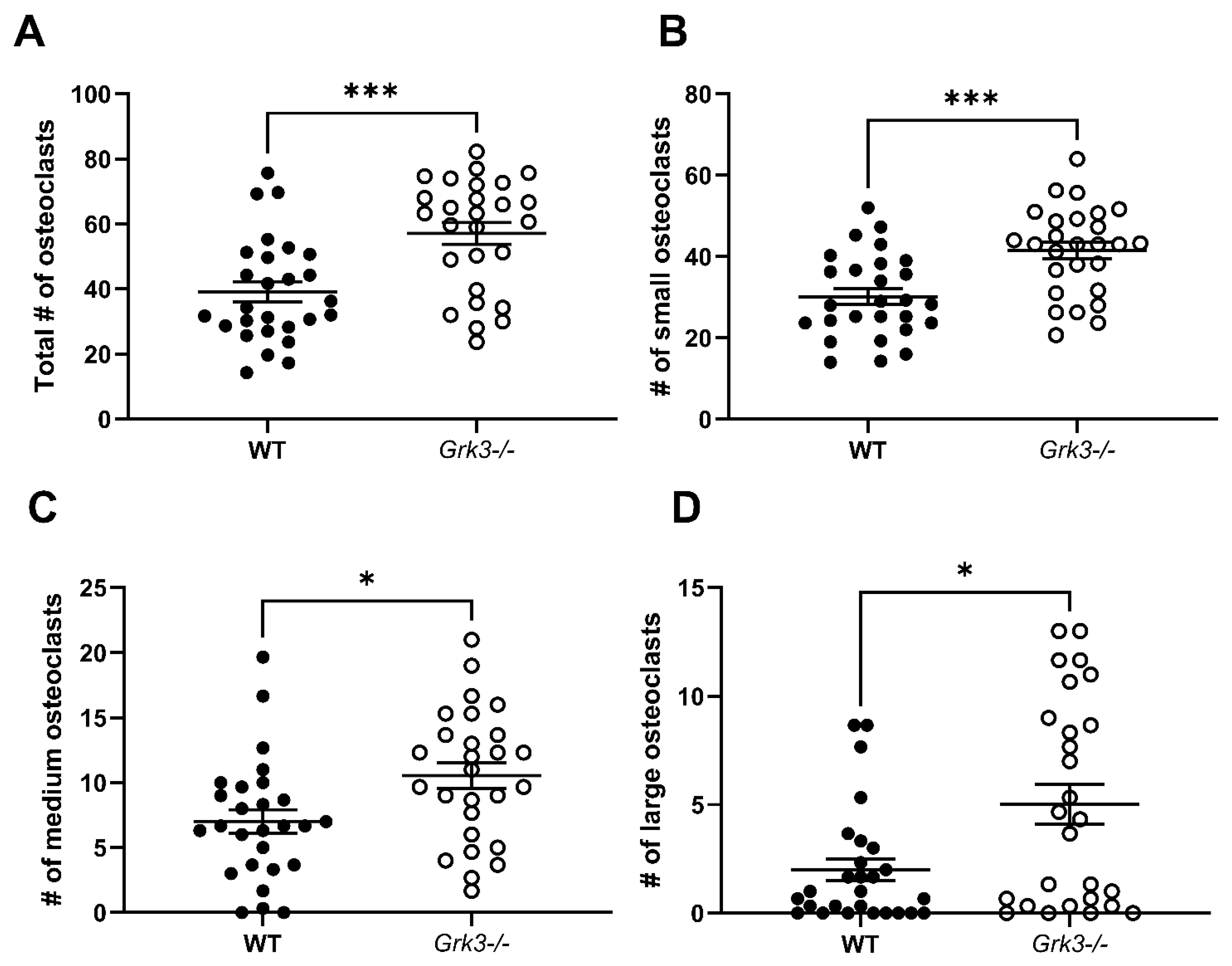
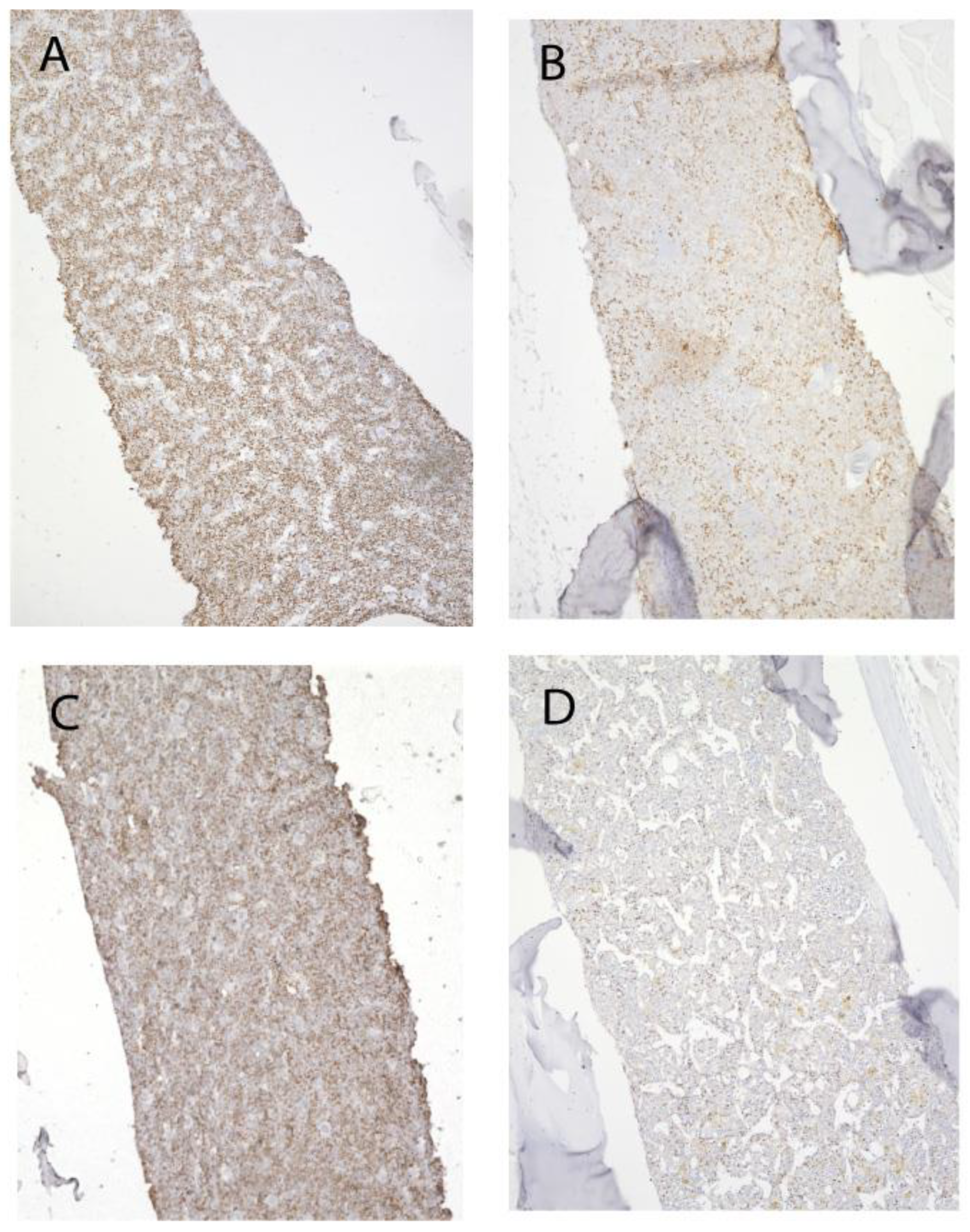
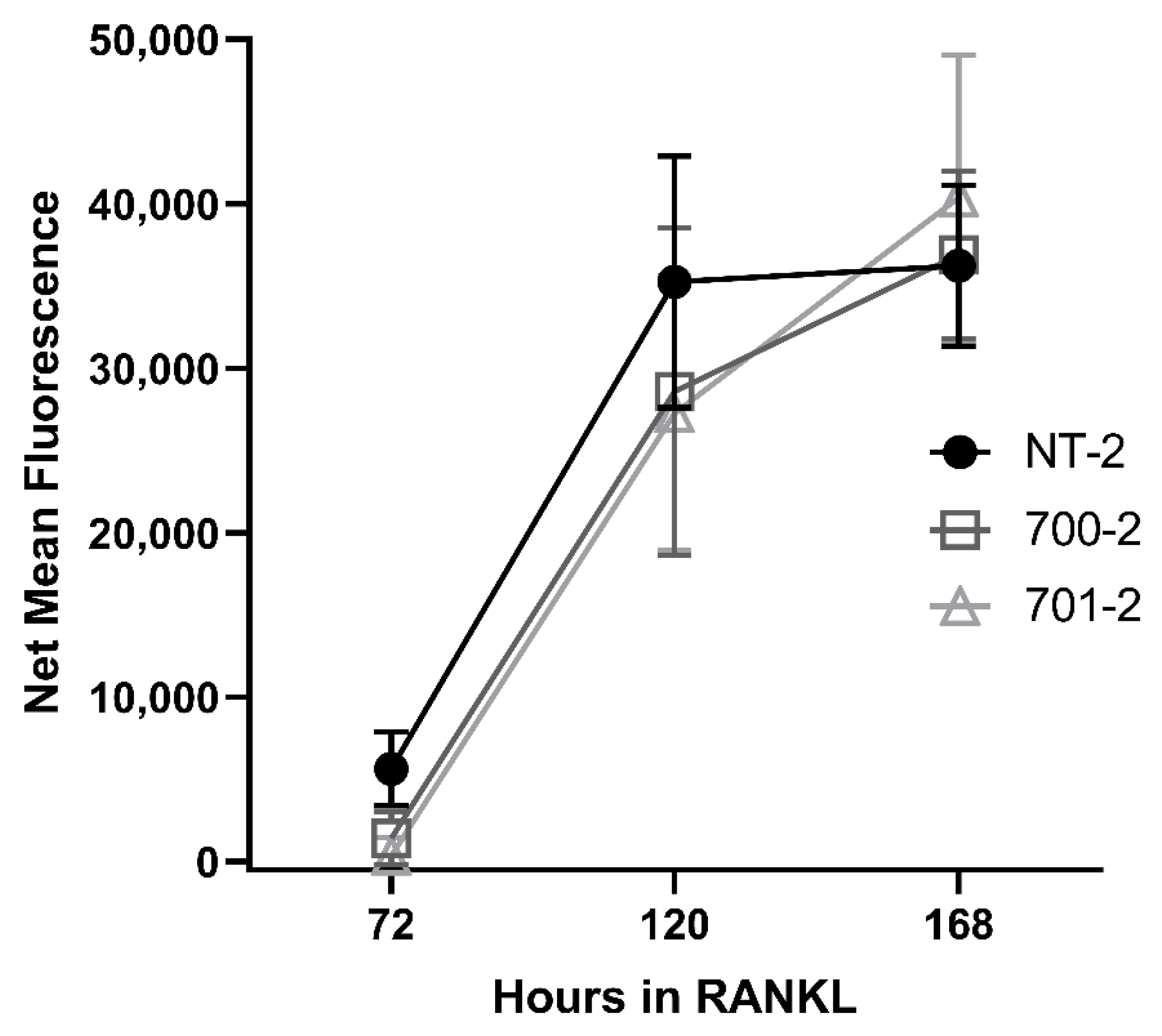

| Aged Grk3−/− Mice | At Least One Lesion Present | Of Those with One Lesion: More Than One Lesion Present |
|---|---|---|
| Male | 87% (13/15) | 69% (9/13) |
| Female | 91% (10/11) | 100% (10/10) |
| Total | 88% (23/26) | 83% (19/23) |
| Publication | GEO Dataset | Cell Type | Experimental Condition | Grk3 Expression |
|---|---|---|---|---|
| [28] | GSE107295 | Human osteoclast precursor cell | Cultured with M-CSF and RANKL to induce osteoclast formation | Grk3 increases with RANKL treatment |
| [29] | GSE63009 | Human peripheral blood cell derived osteoclast precursors | Cultured in M-CSF and RANKL then treated with bisphosphonates | Grk3 expression is sustained in osteoclast precursor cells treated with bisphosphonates |
| [28] | GSE107295 | Mouse bone marrow derived myeloid precursor cells | Cultured with M-CSF +/− RANKL | Grk3 expression increases with RANKL treatment |
| [30] | GSE10246 | Variety of murine tissues | Higher expression of Grk3 in osteoclast precursor cells than other cells in the bone | |
| [30] | GSE10246 | RAW 264.7 cells | Grk3 expression is lower than primary murine bone cell types | |
| [31] | GSE30160 | Mouse bone marrow macrophages with inactivating motif on RANK domain | Culture with M-CSF and RANKL | Grk3 expression induction during osteoclastogenesis is abolished with inactivating mutation in the RANK IVVY domain |
| PDB (n = 18) | Controls (n = 18) | p-Value | |
|---|---|---|---|
| Age (years) | 75.6 ± 12.0 | 73.8 ± 13.6 | 0.89 |
| Female | 13 (72%) | 15 (83%) | 0.69 |
| Grk3/18 s (AU) | 0.83 ± 1.14 | 2.28 ± 3.11 | 0.016 |
Disclaimer/Publisher’s Note: The statements, opinions and data contained in all publications are solely those of the individual author(s) and contributor(s) and not of MDPI and/or the editor(s). MDPI and/or the editor(s) disclaim responsibility for any injury to people or property resulting from any ideas, methods, instructions or products referred to in the content. |
© 2023 by the authors. Licensee MDPI, Basel, Switzerland. This article is an open access article distributed under the terms and conditions of the Creative Commons Attribution (CC BY) license (https://creativecommons.org/licenses/by/4.0/).
Share and Cite
Rabjohns, E.M.; Rampersad, R.R.; Ghosh, A.; Hurst, K.; Eudy, A.M.; Brozowski, J.M.; Lee, H.H.; Ren, Y.; Mirando, A.; Gladman, J.; et al. Aged G Protein-Coupled Receptor Kinase 3 (Grk3)-Deficient Mice Exhibit Enhanced Osteoclastogenesis and Develop Bone Lesions Analogous to Human Paget’s Disease of Bone. Cells 2023, 12, 981. https://doi.org/10.3390/cells12070981
Rabjohns EM, Rampersad RR, Ghosh A, Hurst K, Eudy AM, Brozowski JM, Lee HH, Ren Y, Mirando A, Gladman J, et al. Aged G Protein-Coupled Receptor Kinase 3 (Grk3)-Deficient Mice Exhibit Enhanced Osteoclastogenesis and Develop Bone Lesions Analogous to Human Paget’s Disease of Bone. Cells. 2023; 12(7):981. https://doi.org/10.3390/cells12070981
Chicago/Turabian StyleRabjohns, Emily M., Rishi R. Rampersad, Arin Ghosh, Katlyn Hurst, Amanda M. Eudy, Jaime M. Brozowski, Hyun Ho Lee, Yinshi Ren, Anthony Mirando, Justin Gladman, and et al. 2023. "Aged G Protein-Coupled Receptor Kinase 3 (Grk3)-Deficient Mice Exhibit Enhanced Osteoclastogenesis and Develop Bone Lesions Analogous to Human Paget’s Disease of Bone" Cells 12, no. 7: 981. https://doi.org/10.3390/cells12070981
APA StyleRabjohns, E. M., Rampersad, R. R., Ghosh, A., Hurst, K., Eudy, A. M., Brozowski, J. M., Lee, H. H., Ren, Y., Mirando, A., Gladman, J., Bowser, J. L., Berg, K., Wani, S., Ralston, S. H., Hilton, M. J., & Tarrant, T. K. (2023). Aged G Protein-Coupled Receptor Kinase 3 (Grk3)-Deficient Mice Exhibit Enhanced Osteoclastogenesis and Develop Bone Lesions Analogous to Human Paget’s Disease of Bone. Cells, 12(7), 981. https://doi.org/10.3390/cells12070981






